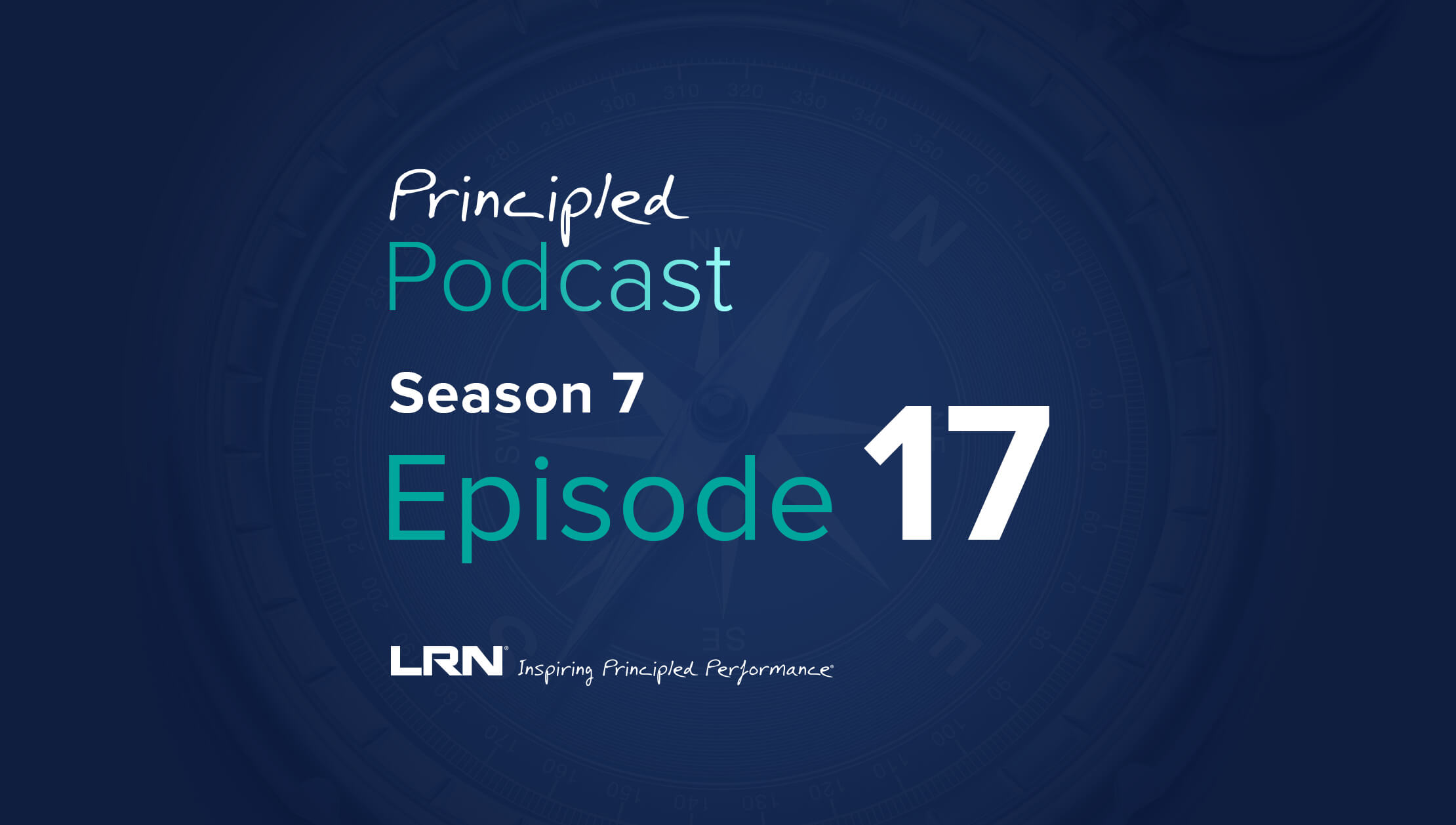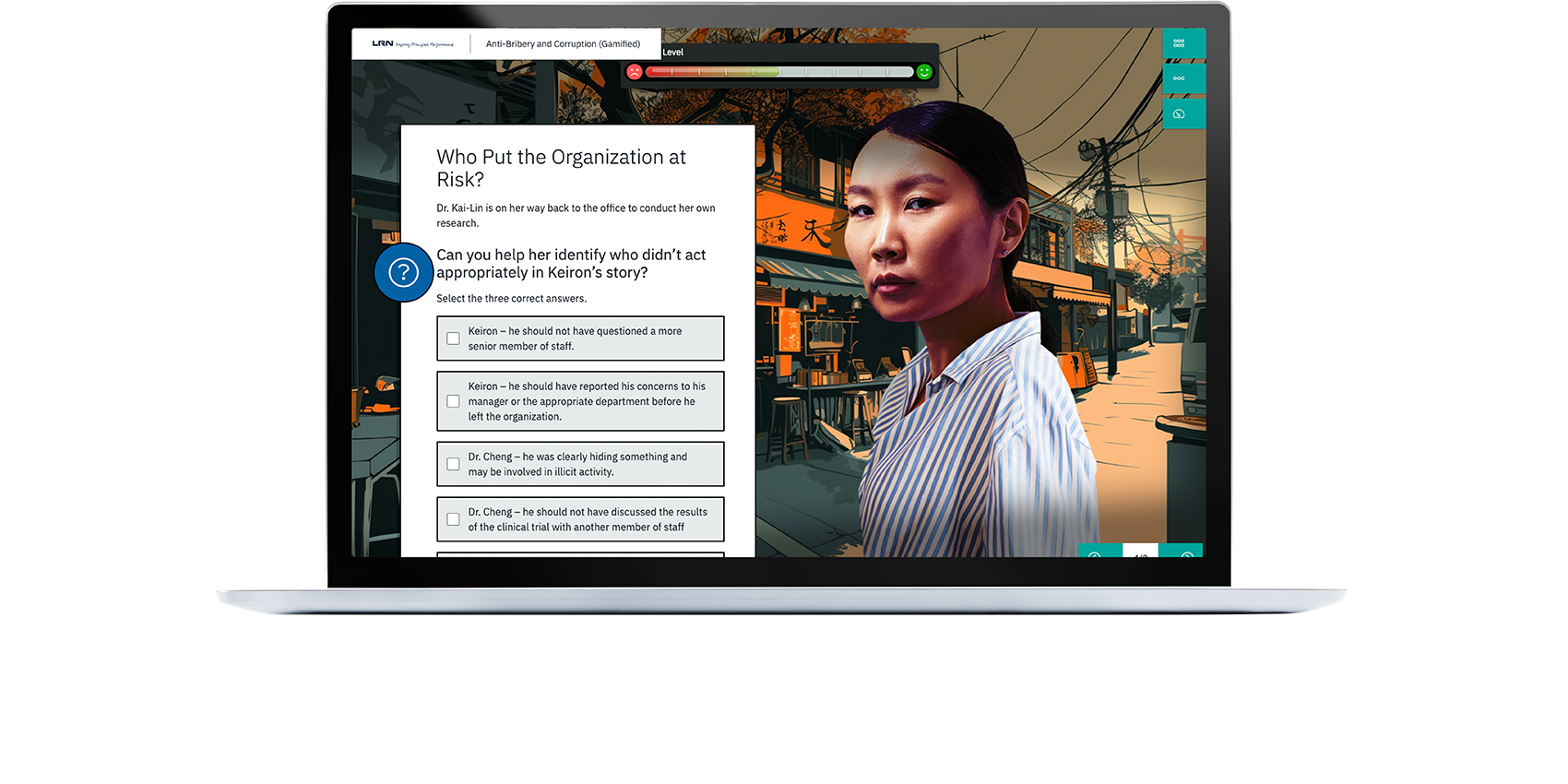What you'll learn on this podcast episode
Good training is not quick to create. It takes time, effort, and years of instructional design experience. And too often, best-in-class training gets derailed by inadequate communications. An effective, attention-grabbing communications strategy is just as important as the quality of the learning itself. How can companies ensure that they’re designing training and communications that produce positive learning experiences and—ultimately—business outcomes? In this episode of LRN’s Principled Podcast Damien DeBarra, leader of Curriculum Design and Communications Strategy at LRN, and Tomaso Manca, learning director at LRN, discuss the importance of intentional curriculum design when developing corporate onboarding. Listen as the two talk about what best practices organizations should consider in their approach.
Principled Podcast Show Notes
- [1:28] - What is meant by the idea of campaigns, not courses?
- [3:47] - Best practices for incentivizing learners.
- [6:11] - The benefits for learners.
- [7:31] - How does LRN approach this campaign-based strategy?
- [9:46] - Examples of ways to retain the attention of your audience.
- [11:54] - Tactics used by LRN to bring the idea of campaigns, not courses to life.
- [15:00] - Tips to ensure people don’t feel overwhelmed by your campaign.
- [17:30] - The LRN difference in this approach.
- [20:40] - Advice for people looking to implement this approach for the first time.
Where to stream
Be sure to subscribe to the Principled Podcast wherever you get your podcasts.
Guest: Tomaso Manca
Tomaso Manca has created exciting learning events for more than 20 years. As a Learning Director at LRN, he works with clients to create engaging learner experiences that support behavioral changes. Before joining LRN, Tomaso spent more than six years as a Learning Manager at Interactive Services. Prior to that, he worked as Best Practices Global Learning Manager at Thomson Reuters, supporting the learning of their Sales Organization. Tomaso holds an M.A. in Economics from Yale University.
Damien DeBarra brings more than 20 years’ experience to the instructional design and strategic workforce planning spaces. As a Senior Advisory Learning Solutions Manager at LRN, he focuses on creating training solutions that ensure business buy-in and connect hiring practices to day-one learning roll-outs. In the last few years, Damien has helped organizations such as United Airlines, Sun Life Financial, SITEL, Astellas, MFS Investments, and SAP create 90-day action plans for their solutions and develop supporting communication strategies. He has worked with over 200 clients in areas ranging from retail to pharmaceuticals, call centers to nuclear plant manufacturing. Prior to LRN, Damien spent more than nine years as the Learning Solutions Director and Head of Instructional Design at Interactive Services. He has also worked as an instructional designer at NCALT, Electric Paper, and Epic. Damien received his BA from Maynooth University.
Principled Podcast Transcription
Intro: Welcome to the Principled Podcast. Brought to you by LRN. The Principled Podcast brings together the collective wisdom on ethics, business and compliance, transformative stories of leadership, and inspiring workplace culture. Listen in to discover valuable strategies from our community of business leaders and workplace change makers.
Damien DeBarra: Good training is not quick to create. It takes time, effort, and years of instructional design experience. Best in class training is too often ruined by inadequate or authoritarian style communications. An effective attention grabbing communication strategy is just as important as the quality of the learning itself. So, how can you ensure that you're designing training and communications that produce positive learning experiences and ultimately positive business outcomes? Hello, and welcome to another episode of LRN's Principled Podcast. I'm Damien DeBarra, the leader of curriculum design and communication strategies at LRN.
Tomaso Manca: And I'm Tomaso Manca, learning director at LRN. As co-host for this episode, we are going to be talking about the importance of intentional curriculum design when developing corporate onboarding, and what best practices to consider in your approach. All right, Damien, let's dive in. Something I've been hearing a lot at LRN is the idea of campaigns and not courses. What do we mean by that?
Damien DeBarra: So campaigns, not courses, it's taken from the name of a talk we did recently at the Learning Technologies Conference in the UK just a month or two ago. And it's reflective of a conversation, which we have a lot here at LRN, which you hear in production, in our delivery teams and in the advisory team where I work. And that is the... We often semi-jokingly refer to it as, "the tragedy." "The tragedy" is that, we see world class learning materials being delivered to the business with a sort of, "or else" style communication. So if you think about it like, the client comes to us and says, "look, it's really important for us to roll out this training initiative around..." For example, B E and I, we make them a world class e-learning course. We develop a brilliant interactive classroom version of that for those who can't do online.
We animate fully bespoke, beautiful videos. There's a whole plethora of support materials ready for the learners to help apply to the job. And the people who've partnered with us are really super psyched and can't wait for the business to get at this. But then the email goes out saying, "Hey, do this course by Friday, or else." It's devastating to your efforts, because as we sometimes like to joke a little bit, people who take online training, particularly online training, they're a little bit like people who ring call centers. And that is that they're already slightly irritated before they get to you. And if you do anything to give them an opportunity to opt out, to give them an opportunity to let that email slide down the inbox and just be ignored, they'll likely grasp it. And it's not because people don't want to learn on the job, it's simply that it's one email and another hundred inside of the day. They've probably got a job to do. They've already got training. They might be behind on... So any kind of blunt order to do a course really doesn't help. So instead, what we try and do is catch people's attentions and then incentivize them, or if you like, seduce them or draw them towards actually exploring those learning assets.
Tomaso Manca: Very interesting, Damien. Can you share the best practice for incentivizing learners?
Damien DeBarra: Sure. Well, we tend to do it slightly differently for... with each client, with each partner and differently for each communication strategy, depending on what's being taught or what needs to be learned. But there does seem to be an emerging best practice and it is nascent, it's really emerging, but that is the move away from what you might call the one and done training deployment towards a more campaign based approach. Campaigns, they're spread out over slightly longer periods of time. The amount of minutes a learner spends in their chair doing the training should be the same, or if even possible, less than whatever they did the previous year. But the campaign is spread out rather. And it's made up... The idea is use microburst trainings and snappy communications. Really engaging videos, try and keep them under one minute, two minutes, maximum. Job aids with exploratory questions to help you focus, and then whatever the medium, whatever the channel, we try and focus on using simple repeated messaging across a period of time in multiple channels.
And if possible, we try and get that messaging going through the business, not just from an actor, as aware in a voiceover, but rather from real people within the organization. So real people within that business, diverse voices and if possible local leaders. So it brings a degree of authenticity to it, but again, back to that idea of, we need to catch people's attention. So whatever communication it is you're sending out around your training launch, it really needs to get people's attention. It has to stand out from the other 99 emails that you might have received that day. The response we want is, we want people to see a headline in an email and go, "oh, what's that?" And click to open it. And it's... It is about drawing people in and avoiding the language you normally associate around training. The very instructional designer language, the very people and culture departments. So human resources department's language, moving away from all that language around learning and trying to make it sound and feel not like training but more like a marketing campaign for something really cool. That's going to make you better at your job.
Tomaso Manca: So we're talking about using language that draws the learner in, within a campaign based strategy. What are the benefits for our learners?
Damien DeBarra: Well, there's a number of them, as we said, the first one is to try and take the sting out of being asked to do training when you've already got a multiple... a long series of tasks to do in your day. So as we said, we know people, a lot of people... if we give them an opportunity to leave that email alone, they will. Also... I alluded to this a couple of months ago, that language of instructional design we're all kind of used to hearing, "by the end of this course, you will be able to..." Whilst that has its place, if we can use a different kind of tone and approach, what you might call a more magazine style of writing, it's much more human. It's much more relatable. And it benefits the learner because, basically we want to try and increase and drive engagement.
So it's about trying to make the materials not sound like training, it's something that's going to be where you're being talked at. And the benefit of the learner is, as I say, primarily engagement. Keep them guessing, kind of engaged in thinking, "what's going to happen next? What's this about?" You've told them there's something in it for them, but using good copywriting and clever headlines, and also simple questions to draw people into wanting the answers to those questions. So the benefit, I'd say probably in summary, if you were to reduce it to one word, it would probably be engagement.
Tomaso Manca: And how does LRN approach this campaign based strategy?
Damien DeBarra: Well, like I said, it's different for every partner, but there are common tools. So, the idea is to have a carefully targeted communication strategy that is, we determine what the core messages are that we want in the comms campaign. We determine when we want to release them. Not everything should go out at the same time. And we want to repeat those as a series of simple focus messages through multiple channels. So yes, the email is the obvious one, because that's... things go to the inbox. It's the primary point to contact, but we also like to use internal communications channels. So for example, if you're within the Microsoft Office environment, as many of our clients are, let's start pushing stuff through Microsoft teams or through Yammer or through Slack, if that's where your environment is for internal discussion.
And also, it doesn't have to be digital. So for example, we create off, sometimes physical assets. So posters that go on walls in common areas within manufacturing environments is a classic one. Tent cards that sit on tables with a QR code. Again, seductive headline. "What's that about?" You take your phone out, maybe scan a QR code and it launches you to a 62nd advertisement about the campaign. So we do it a multiplicity of different ways, but the idea is that we work with you, your partners and communication specialists within those partners, to create a calendar strategy that's tailored for your needs. It's about getting the right messages and the right headlines delivered in the right channels. It's important to spread the messaging across different channels to make sure that we hit everybody in as many places as we can, at the same time as trying not to oversaturate the business with too many communications. So it's a bit of a balancing act between those two things.
Tomaso Manca: These are great points, Damien. I think it's important to make sure, as you were saying, to cut through the noise. Ensure that the learners hear what they need to hear in a form that resonates and connects with them. You want to engage and excite people, as you were saying.
Damien DeBarra: Exactly. You do. You want to engage and excite people. And in fact, I'll just throw the microphone back to you for a second and ask you. You've written stuff like this as well, and had a lot of experience of this at the deployment level, at the individual communication level. Could you give us a couple of examples of what that looks like tactically? Some of the approaches and ideas you've used.
Tomaso Manca: Well there are a few things to keep in mind, first of all, talk about real people and real issue that will resonate with your audience. And use messages that are simple and direct. For instance, with a client of ours, a large multinational food conglomerate, we have scheduled design workshops that focus on creating targeted messages. Representatives from the target audience are invited to each workshop and they help tailor the message and provide immediate feedback on whether the message will resonate with their peers or not. You also want to deliver those messages using multiple formats to ensure you capture the attention of your audience, something you already touched upon. A good example is a communication program you are creating for a large chemical company. Every month, we generate a message that fits within the client's larger communication initiatives. And so far we used a variety of medium.
We use graphically announced email blasts. Actual poster to be placed in the client's office, and short videos. We plan on adding podcasts and user generated video content next. And speaking about medium, the choice of medium barriers depending on the message and the desire to impact. You want to ensure that the content and the format go hand in hand, that they're aligned and true to your brand, your voice and your audience. The feedback we keep receiving from our clients is that these tips really help engage in their audiences as the messages come across as relevant, flexible, and timely. I know I covered only a handful of examples, so I'm going to bounce it back over to you then and ask you, what additional tech do we use at LRN to really bring campaigns, not courses, to life?
Damien DeBarra: So it's a little bit of the kitchen sink approach. Our strategies leverage the full LRN toolkit. So we've mentioned multichannel approaches like, using emails, using online training, but we also can design virtual classroom events. There's the email and comms campaigns I've mentioned. Internet, banner adverts, SharePoint, or WordPress built websites, to back up the training materials. But we also have our... We have a campaign manager tool, which allows you, the client, to log into the LRN platform, plan out the entire comm strategy, put all the copy... and schedule the entire thing, to send out the emails or the comms at exactly the time you want weeks and months in advance. And it enables you to do a load of work up front and then sit back and let the system take care of it. Ultimately, we can write the... work out the comm strategy for you, write the copy and the headlines and provide the visual assets, and then hand them over to the partner to deliver themselves.
This is a 50-50 split on what partners want. Some want to control that release themselves internally, and others want us to do everything for them, or have a tool that does everything for them. But we use everything, job aids and videos, microsites. Also help lines, chat channels in teams and Slack and other tools like that. And then crucially there's one overlooked thing, which is leader accountability programs. In the past, we've grandly called this, the accountability principle. And that's a slightly fancy pants way of saying something quite simple but very important. And that is... That if you bring leaders into the process of the training, it has a dramatic effect. So if you consider the two... the following two ideas... following two communications, "Hey Tomaso, I want you to do this training course by the end of the month."
That's of relative interest. If I say in the communication, "Hey, Tomaso, I need you to do this training by the end of the month." And one week afterwards, your leader slash manager is going to have a conversation with you about this for 10 minutes. I think your interest level, your amount of skin in the game dramatically increases. And an even better version of that is, "Hey Tomaso, do the course." Now then you're going to talk to your leader, "and by the way, this affects, or connects to your annual performance review." That's a really powerful incentive. So, a leader accountability and leader involvement, or just general accountability for your participation in training is very, very powerful. So it nudges the learner, we think, from being potentially passive, into a very active role within their own learning journey.
Tomaso Manca: I could see that having clear incentives linked to the overall job performance is a very powerful motivator. I really like, also, the imagery you used of the kitchen sink approach. And I'm also thinking that some people might hear this expression and worry that it could lead to information overload. What are some tips to make sure that people don't feel overwhelmed by your campaign?
Damien DeBarra: Yeah, it's a really important concern because it can go too far. I saw a campaign recently we were designing, when it was getting out of hand. We were sending out, potentially discussing sending out 8, 9, 10 communications around something which was actually only a 30 minute training course. And that's probably far too excessive. So you have to work with the partner to make sure that we're not overdoing it. And also, it's about being judicious and careful in what you say in the communications. So two obvious things to say, the first of which is, if you're sending somebody an email about a training initiative, make it short. Make sure that the email is written as snappily, and as eyecatchingly as the training should be written itself. And then the second thing is, if you're worried that people are getting too many communications and there's too much training and too much time spent on training is a common complaint we hear.
Actually make a virtue of the issue of time. So for example, you can say to the learner, "put the time into the title." So let's say something like, "the 20 minute code of conduct training." Okay, that's a very awful title, but put the time into the title and say something like, "invest 20 minutes in doing this now. And you'll be prepared for your annual review." "Spend 30 minutes on this training course, and you'll be able to do this, this, and this in your job." So again, it's back to what you and I often talk about the whiffing. The, "what's in it for me?" Explain to the learner how much time... how little time you want them to spend. In fact, "look, we've reduced it to 20 minutes, because we've heard you, there's too much training. It's taking too long. We heard you, it's now down to 10 minutes every month."
So again, if it's a campaign and it's spread out across a quarter, rather than asking them to do a 40 minute course, tell them, "you're going to do 10 minutes every week for the next four weeks. And as a result, you're going to be safe in your job. The company's going to benefit and you'll be ready for your performance to do... and you'll be able to serve your customers and our communities and our shareholders." And so on. So I would say if you're worried about them... if the partners expressing their concern or you have a concern about there being too much time spent on this, or if it's just overload, make a virtue of talking about how it actually saves time in the long run.
Tomaso Manca: Makes sense to me. And when it comes to this approach, what do you think is the LRN difference?
Damien DeBarra: So I could probably talk to you all day about tech and campaign managers and our disclosure tools and how there's a lot of technology to talk about. But actually, sometimes I think that the power of good copywriting can't be underrated. So we deploy a lot of cutting edge technology to drive solutions, but sometimes the most powerful tool we've got is one simple eye-catching headline. So we know, as we've just been discussing, that learners are time poor. They're training wary, so we place a strong emphasis on getting their attention using snappy headlines to drive people to the training assets.
Tomaso Manca: Interesting. Can you share some more examples of successful copywriting?
Damien DeBarra: I can probably share a few headlines. I won't name the partners themselves, but one springs to mind is, Large North American Financial Firm. That's as far as I'll go in describing it. And their problem was, very much like we were just discussing, learners getting way too many communications around having to do training. The communications were a bit on the blunt side, borderline rude in one or two... in cases. And learners were telling us via data in surveys and in focus groups that they were just really quite fed up with this. So the approach we took was, we knew that we had to get their attention in five to 10 seconds. Getting their eyeballs or they were gone. So what we did was, we opened up a campaign, and the first email in the campaign, the headline said, and it was deliberately written in capital letters.
It said, "I can't wait to do compliance training this year." And then when you clicked on the mail, the next line was, "said, no one ever." That's the headline to grab your attention. And then the next thing is, it said, "we hear you. We've got it. You've told us through focus groups that it's taking too long to do training. So what we've done is, we've reduced everything down to 20 minute buckets per quarter or per month." I think it was. Another example was, from the same campaign in fact, was that, for reasons which aren't entirely understood or there seems to be a different set of reasons for different clients, fishing scans spike in August and September. So what we did there was, we sent out an email. I think it was in August and the headline in that one was, "you are a danger to yourself and others."
So deliberately provocative headlines. And there's about 12 different subjects in that communications campaign, but they all took that approach. I hesitate to call them click bait headlines, because that's an awful term, but it was something designed to make you go, "what? What's that?" And hopefully you click. Again, that principle of having got their attention with the headline within 30 seconds or even 30 words. You should tell them in the first paragraph this is why you've clicked and this is what you're going to get and how long it's going to take you to do it. And again, that thing, the whiff and "what's in it for me" explaining that, if you do this, it will make you better at your job, et cetera. So getting their attention and explaining what the value is for them.
Tomaso Manca: And I can see that it all boils down to writing. Damien, you've touched... certainly you've touched on a lot of great points about the value of taking what we are calling a campaign, not courses, approach. And I think this will inspire a lot of our listeners to consider for their own training. So what advice would you give to people who are looking to implement this approach for the first time?
Damien DeBarra: Well, at the risk... That's a great question. So at the risk of potentially starting with something negative, get ready for resistance. A lot of the times the heartbreaking thing we hear sometimes when we're talking to our partners is, I kind give them this pitch and then they say, "that's brilliant. That's never going to work here." See, it's that classic line. "That's fantastic, now let me tell you why I won't work for our company." And it's because a lot of people are wedded to the particular calendar of release at one time of the year. And we understand that's a necessity for certain partners and clients, particularly if it's a very big program. We understand why they might want to get it all done in one quarter so the learners don't feel it's dragging on over the year. But if you have one particular smaller training initiative, you might consider that campaign based approach, but get ready for resistance.
People will be skeptical about it. Some folks just won't want to do it. You also, when you get into doing communications around this, you'll also need to bring in other partners from across the business. So traditionally, if you're the training manager at a company, small to medium enterprise, I don't know, a couple of hundred staff, the training department might be you... might be just one person. But now you're talking comm, so you've got to bring in your communications team. They have their own calendars. They have their own priorities for things that need to be communicated to the business. And a common one we hear is... from our learning and development partners is, "that's great, but the communications team are already telling me there's too many communications." So get ready for that conversation. Get ready to try and influence the other stakeholders in your business to understand the benefits of taking this different approach.
And to do that, you might try and arm yourself. This is easier said than done. Too massive, right? But you might try and arm yourself with a case to make that change. And that's in the form of some data. So are you able to get a survey from your current learners on... let's say on your last year's training on, how your learners liked it? Get that survey data. Now that might be painful because that survey data might reveal that they really don't like the training and it can be hard not to take that personally. And you might think to yourself, "do I really want people in the business scene, the feedback we're getting?" And an even more powerful... Sometimes in addition to a cluster of data from a large number of learners, is anecdotal information taken from focus groups. So a classic trick... not trick, but a classic approach we've done a few times is to bring in a group of learners into a focus group. Keep the training and development people out of the room. That might sound cruel, but you want people to feel free to speak freely. And of that five or six people, you might have a bit of a spectrum of learners. That is saying a couple of learners who have been in the business a number of years, who'd probably be training wary, that might be a bit tired of all this.
And maybe a couple of learners who are newbies who've just gone through the training, have not yet been at the company long enough to be completely drawn into the culture, and they can often give you very fresh observations. So I suppose what I'm saying is, get ready to have the conversations and get ready for that resistance, but also try to strike a balance. As I said, if there's a possibility you can overdo this, where you can go hog wild, go crazy and start communicating to the business on everything. And that can become even more irritating than the blunt once a year communication. So there's a balance to be struck all the time. I hope that answers your question. Not sure I have.
Tomaso Manca: Oh, absolutely. It does. And it opens up a lot of other questions. You and I can probably be talking about strategy for the rest of the day, but it looks like we are out of time for today.
Damien DeBarra: Yeah, we should probably wrap it up. And it's always great talking to you about this stuff Tomaso. Thanks for the time.
Tomaso Manca: Likewise. And thanks to our listeners. My name is Tomaso Manca.
Damien DeBarra: And I'm Damien DeBarra. And I'd like to thank you all for listening to the principal podcast by LRN.
Outro: We hope you enjoyed this episode. The Principled Podcast is brought to you by LRN. At LRN, our mission is to inspire principled performance in global organizations, by helping them foster winning ethical cultures, rooted in sustainable values. Please visit us at LRN.com to learn more. And if you enjoyed this episode, subscribe to our podcast on Apple podcasts, Stitcher, Google podcasts, or wherever you listen. And don't forget to leave us a review.
Be sure to subscribe to the Principled Podcast wherever you get your podcasts.
















